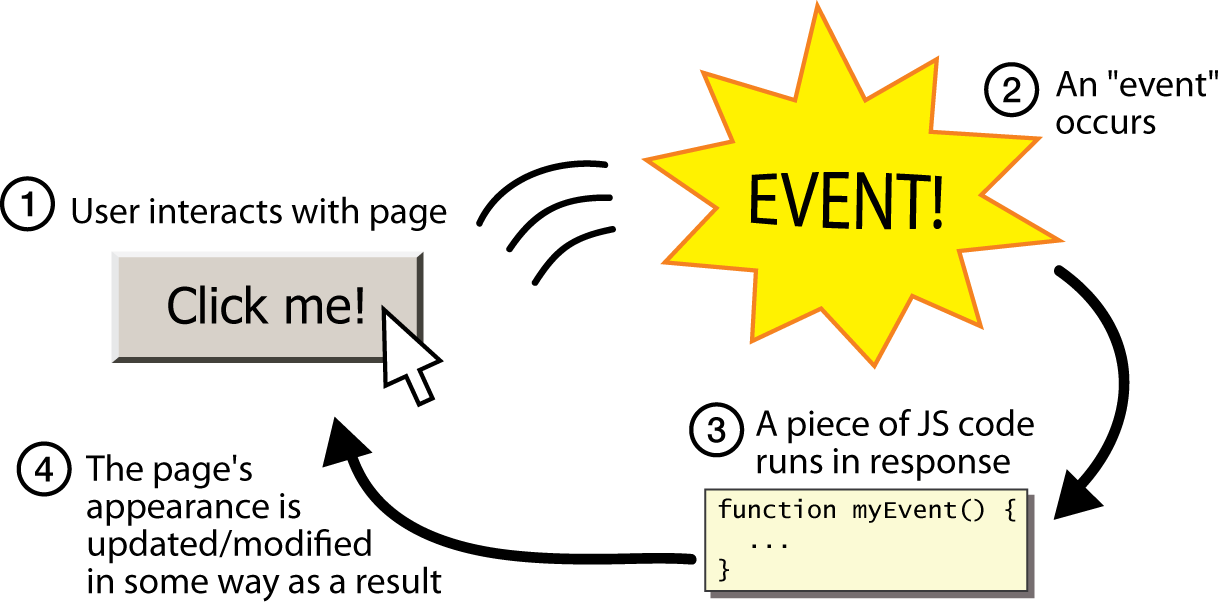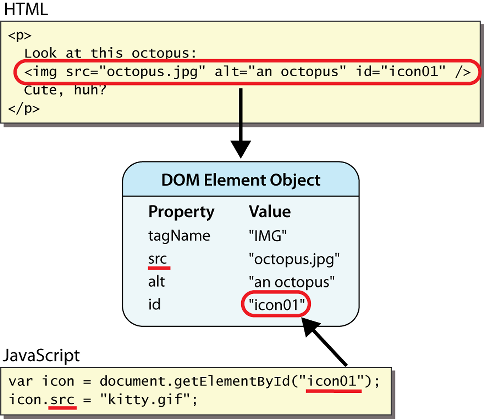CSE 190M Web Programming
Lecture 13: JavaScript
Reading: 8.1 - 8.4
Except where otherwise noted, the contents of this document are Copyright 2012 Marty Stepp, Jessica Miller, Victoria Kirst and Roy McElmurry IV. All rights reserved. Any redistribution, reproduction, transmission, or storage of part or all of the contents in any form is prohibited without the author's expressed written permission.
8.1: Key JavaScript Concepts
- 8.1: Key JavaScript Concepts
- 8.2: JavaScript Syntax
- 8.3: Program Logic
- 8.4: Advanced JavaScript Syntax
Client-side scripting

- client-side script: code runs in browser after page is sent back from server
- often this code manipulates the page or responds to user actions
Why use client-side programming?
PHP already allows us to create dynamic web pages. Why also use client-side scripting?
-
client-side scripting (JavaScript) benefits:
- usability: can modify a page without having to post back to the server (faster UI)
- efficiency: can make small, quick changes to page without waiting for server
- event-driven: can respond to user actions like clicks and key presses
-
server-side programming (PHP) benefits:
- security: has access to server's private data; client can't see source code
- compatibility: not subject to browser compatibility issues
- power: can write files, open connections to servers, connect to databases, ...
What is JavaScript?
- a lightweight programming language ("scripting language")
- used to make web pages interactive
- insert dynamic text into HTML (ex: user name)
- react to events (ex: page load user click)
- get information about a user's computer (ex: browser type)
- perform calculations on user's computer (ex: form validation)
- a web standard (but not supported identically by all browsers)
- NOT related to Java other than by name and some syntactic similarities
JavaScript vs. Java
 +
+
 = JavaScript
= JavaScript
- interpreted, not compiled
- more relaxed syntax and rules
- fewer and "looser" data types
- variables don't need to be declared
- errors often silent (few exceptions)
- key construct is the function rather than the class
- "first-class" functions are used in many situations
- contained within a web page and integrates with its HTML/CSS content
JavaScript vs. PHP
JS <3


- similarities:
- both are interpreted, not compiled
- both are relaxed about syntax, rules, and types
- both are case-sensitive
- both have built-in regular expressions for powerful text processing
- differences:
- JS is more object-oriented:
noun.verb(), less procedural:verb(noun) - JS focuses on UIs and interacting with a document; PHP on HTML output and files/forms
- JS code runs on the client's browser; PHP code runs on the web server
- JS is more object-oriented:
8.2: JavaScript Syntax
- 8.1: Key JavaScript Concepts
- 8.2: JavaScript Syntax
- 8.3: Program Logic
- 8.4: Advanced JavaScript Syntax
A JavaScript statement:
alert
alert("message");
alert("IE6 detected. Suck-mode enabled.");

- a JS command that pops up a dialog box with a message
Variables and types
var name = expression;
var age = 32; var weight = 127.4; var clientName = "Connie Client";
- variables are declared with the
varkeyword (case sensitive) - types are not specified, but JS does have types ("loosely typed")
Number,Boolean,String,Array,Object,Function,Null,Undefined- can find out a variable's type by calling
typeof
Number type
var enrollment = 99; var medianGrade = 2.8; var credits = 5 + 4 + (2 * 3);
- integers and real numbers are the same type (no
intvs.double) -
same operators:
+ - * / % ++ -- = += -= *= /= %= - similar precedence to Java
- many operators auto-convert types:
"2" * 3is6
String type
var s = "Connie Client";
var fName = s.substring(0, s.indexOf(" ")); // "Connie"
var len = s.length; // 13
var s2 = 'Melvin Merchant'; // can use "" or ' '
- methods:
charAt,charCodeAt,fromCharCode,indexOf,lastIndexOf,replace,split,substring,toLowerCase,toUpperCasecharAtreturns a one-letterString(there is nochartype)
lengthproperty (not a method as in Java)-
concatenation with
+:1+ 1 is2, but"1"+ 1 is"11"
More about String
-
escape sequences behave as in Java:
\' \" \& \n \t \\ - to convert between numbers and
Strings:var count = 10; var s1 = "" + count; // "10" var s2 = count + " bananas, ah ah ah!"; // "10 bananas, ah ah ah!" var n1 = parseInt("42 is the answer"); // 42 var n2 = parseFloat("booyah"); // NaN
- to access characters of a
String, use [index] orcharAt:var firstLetter = s[0]; var firstLetter = s.charAt(0); var lastLetter = s.charAt(s.length - 1);
Comments (same as Java)
// single-line comment
/* multi-line comment */
- identical to Java's comment syntax
- recall: 4 comment syntaxes
- HTML:
<!-- comment --> - CSS/JS/PHP:
/* comment */ - Java/JS/PHP:
// comment - PHP:
# comment
- HTML:
for loop
(same as Java)
for (initialization; condition; update) {
statements;
}
var sum = 0;
for (var i = 0; i < 100; i++) {
sum = sum + i;
}
var s1 = "hello";
var s2 = "";
for (var i = 0; i < s.length; i++) {
s2 += s1[i] + s1[i];
}
// s2 stores "hheelllloo"
Math object
var rand1to10 = Math.floor(Math.random() * 10 + 1); var three = Math.floor(Math.PI);
Logical operators
-
> < >= <= && || ! == != === !== -
most logical operators automatically convert types:
-
5 < "7"istrue -
42 == 42.0istrue -
"5.0" == 5istrue
-
-
===and!==are strict equality tests; checks both type and value-
"5.0" === 5isfalse
-
if/else statement
(same as Java)
if (condition) {
statements;
} else if (condition) {
statements;
} else {
statements;
}
- identical structure to Java's
if/elsestatement - JavaScript allows almost anything as a condition
Boolean type
var iLike190M = true; var ieIsGood = "IE6" > 0; // false if ("web dev is great") { /* true */ } if (0) { /* false */ }
-
 any value can be used as a
any value can be used as a Boolean-
"falsey" values:
0,0.0,NaN,"",null, andundefined - "truthy" values: anything else
-
"falsey" values:
- converting a value into a
Booleanexplicitly:var boolValue = Boolean(otherValue);var boolValue = !!(otherValue);
while loops
(same as Java)
while (condition) {
statements;
}
do {
statements;
} while (condition);
breakandcontinuekeywords also behave as in Java
Arrays
var name = []; // empty array var name = [value, value, ..., value]; // pre-filled name[index] = value; // store element
var ducks = ["Huey", "Dewey", "Louie"]; var stooges = []; // stooges.length is 0 stooges[0] = "Larry"; // stooges.length is 1 stooges[1] = "Moe"; // stooges.length is 2 stooges[4] = "Curly"; // stooges.length is 5 stooges[4] = "Shemp"; // stooges.length is 5
- two ways to initialize an array
lengthproperty (grows as needed when elements are added)
Array methods
var a = ["Stef", "Jason"]; // Stef, Jason a.push("Brian"); // Stef, Jason, Brian a.unshift("Kelly"); // Kelly, Stef, Jason, Brian a.pop(); // Kelly, Stef, Jason a.shift(); // Stef, Jason a.sort(); // Jason, Stef
Splitting strings:
split and join
var s = "the quick brown fox";
var a = s.split(" "); // ["the", "quick", "brown", "fox"]
a.reverse(); // ["fox", "brown", "quick", "the"]
s = a.join("!"); // "fox!brown!quick!the"
-
splitbreaks apart a string into an array using a delimiter-
can also be used with regular expressions surrounded by
/:var a = s.split(/[ \t]+/);
-
can also be used with regular expressions surrounded by
joinmerges an array into a single string, placing a delimiter between them
Defining functions
function name() {
statement ;
statement ;
...
statement ;
}
function myFunction() {
alert("Hello!");
alert("How are you?");
}
- the above could be the contents of
example.jslinked to our HTML page - statements placed into functions can be evaluated in response to user events
Special values: null and undefined
var ned = null;
var benson = 9;
var caroline;
// at this point in the code,
// ned is null
// benson's 9
// caroline is undefined
undefined: has not been declared, does not existnull: exists, but was specifically assigned an empty ornullvalue- Why does JavaScript have both of these?
Event-Driven Programming with JavaScript
- 8.1: Key JavaScript Concepts
- 8.2: JavaScript Syntax
- 8.3: Program Logic
- 8.4: Advanced JavaScript Syntax
Event-driven programming

- JS programs have no
main; they respond to user actions called events - event-driven programming: writing programs driven by user events
Linking to a JavaScript file:
script
<script src="filename" type="text/javascript"></script>
<script src="example.js" type="text/javascript"></script>
scripttag should be placed in HTML page'shead- script code is stored in a separate
.jsfile - JS code can be placed directly in the HTML file's
bodyorhead(like CSS)- but this is bad style (should separate content, presentation, and behavior)
Exercise: Link tip CSS
- Link javascript code into our tip.html page.
Buttons:
<button>
the canonical clickable UI control (inline)
<button>Click me!</button>
- button's text appears inside tag; can also contain images
- To make a responsive button or other UI control:
- choose the control (e.g. button) and event (e.g. mouse click) of interest
- write a JavaScript function to run when the event occurs
- attach the function to the event on the control
Event handlers
<element attributes onclick="function();">...
<button onclick="myFunction();">Click me!</button>
- JavaScript functions can be set as event handlers
- when you interact with the element, the function will execute
onclickis just one of many event HTML attributes we'll use
-
but popping up an
alertwindow is disruptive and annoying- A better user experience would be to have the message appear on the page...
Exercise: onclick alert
- Write the necessary javascript so that an alert is made when the button is clicked.
Document Object Model (DOM)
a set of JavaScript objects that represent each element on the page

- most JS code manipulates elements on an HTML page
- we can examine elements' state
- e.g. see whether a box is checked
- we can change state
- e.g. insert some new text into a
div
- e.g. insert some new text into a
- we can change styles
- e.g. make a paragraph red
DOM element objects

- every element on the page has a corresponding DOM object
-
access/modify the attributes of the DOM object with
objectName.attributeName
Accessing elements: document.getElementById
var name = document.getElementById("id");
<button onclick="changeText();">Click me!</button> <input id="output" type="text" value="replace me" />
function changeText() {
var textbox = document.getElementById("output");
textbox.value = "Hello, world!";
}
-
document.getElementByIdreturns the DOM object for an element with a givenid -
can change the text in most form controls by setting the
valueproperty
More advanced example
<button onclick="swapText();">Click me!</button> <span id="output2">Hello</span> <input id="textbox2" type="text" value="Goodbye" />
function swapText() {
var span = document.getElementById("output2");
var textBox = document.getElementById("textbox2");
var temp = span.innerHTML;
span.innerHTML = textBox.value;
textBox.value = temp;
}
-
can change the text inside most elements by setting the
innerHTMLproperty
Exercise: tip calculator
- Write the necessary javascript code to calculate a tip and inject it in the page.
9.1.1: Unobtrusive JavaScript
-
9.1: Global DOM Objects
- 9.1.1 Unobtrusive JavaScript
- 9.1.2 Anonymous Functions
- 9.1.3 The Keyword
this
- 9.2: DOM Element Objects
- 9.3: The DOM Tree
Unobtrusive JavaScript
- JavaScript event code seen previously was obtrusive, in the HTML; this is bad style
- now we'll see how to write unobtrusive JavaScript code
- HTML with minimal JavaScript inside
- uses the DOM to attach and execute all JavaScript functions
- allows separation of web site into 3 major categories:
- content (HTML) - what is it?
- presentation (CSS) - how does it look?
- behavior (JavaScript) - how does it respond to user interaction?
Obtrusive event handlers (bad)
<button onclick="okayClick();">OK</button>
// called when OK button is clicked
function okayClick() {
alert("booyah");
}
- this is bad style (HTML is cluttered with JS code)
- goal: remove all JavaScript code from the HTML body
Attaching an event handler in JavaScript code
// where element is a DOM element object
element.onevent = function;
<button id="ok">OK</button>
var okButton = document.getElementById("ok");
okButton.onclick = okayClick;
- it is legal to attach event handlers to elements' DOM objects in your JavaScript code
- notice that you do not put parentheses after the function's name
- this is better style than attaching them in the HTML
- Where should we put the above code?
Exercise: unobtrusive tip calculator
- Modify the code to be unobtrusive.
When does my code run?
<html> <head> <script src="myfile.js" type="text/javascript"></script> </head> <body> ... </body> </html>
// global code
var x = 3;
function f(n) { return n + 1; }
function g(n) { return n - 1; }
x = f(x);
- your file's JS code runs the moment the browser loads the
scripttag- any variables are declared immediately
- any functions are declared but not called, unless your global code explicitly calls them
- at this point in time, the browser has not yet read your page's
body- none of the DOM objects for tags on the page have been created yet
A failed attempt at being unobtrusive
<html> <head> <script src="myfile.js" type="text/javascript"></script> </head> <body> <div><button id="ok">OK</button></div>
// global code document.getElementById("ok").onclick = okayClick; // error: null
- problem: global JS code runs the moment the script is loaded
- script in
headis processed before page'sbodyhas loaded- no elements are available yet or can be accessed yet via the DOM
- we need a way to attach the handler after the page has loaded...
The window.onload event
// this will run once the page has finished loading function functionName() { element.event = functionName; element.event = functionName; ... } window.onload = functionName; // global code
- we want to attach our event handlers right after the page is done loading
- there is a global event called
window.onloadevent that occurs at that moment
- there is a global event called
- in
window.onloadhandler we attach all the other handlers to run when events occur
An unobtrusive event handler
<button id="ok">OK</button> <!-- look Ma, no JavaScript! -->
// called when page loads; sets up event handlers function pageLoad() { document.getElementById("ok").onclick = okayClick; } function okayClick() { alert("booyah"); } window.onload = pageLoad; // global code
Common unobtrusive JS errors
- many students mistakenly write
()when attaching the handlerwindow.onload = pageLoad
(); window.onload = pageLoad; okButton.onclick = okayClick(); okButton.onclick = okayClick;- our JSLint checker will catch this mistake
- event names are all lowercase, not capitalized like most variables
window.
onLoad= pageLoad; window.onload = pageLoad;
Anonymous functions
function(parameters) {
statements;
}
- JavaScript allows you to declare anonymous functions
- quickly creates a function without giving it a name
- can be stored as a variable, attached as an event handler, etc.
Anonymous function example
window.onload = function() {
var okButton = document.getElementById("ok");
okButton.onclick = okayClick;
};
function okayClick() {
alert("booyah");
}
- or the following is also legal (though harder to read):
window.onload = function() {
var okButton = document.getElementById("ok");
okButton.onclick = function() {
alert("booyah");
};
};
Exercise: unobtrusive tip calculator 2
- Modify the code to have a working unobtrusive solution.
- Change the color of the total text using
element.style.color.
Unobtrusive styling
function okayClick() {
this.style.color = "red";
this.className = "highlighted";
}
.highlighted { color: red; }
- well-written JavaScript code should contain as little CSS as possible
- use JS to set CSS classes/IDs on elements
- define the styles of those classes/IDs in your CSS file

